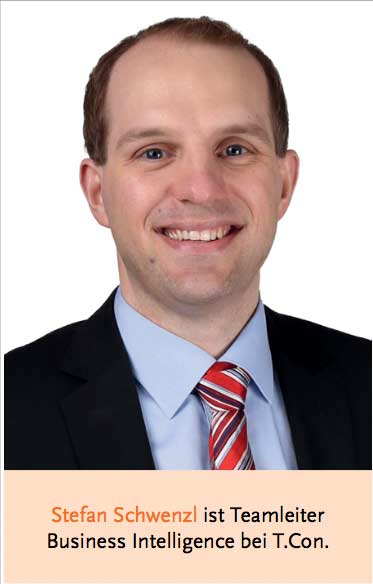The future of data warehousing


In the course of the digital transformation - key words Big Data, Industry 4.0 or Internet of Things (IoT) - the demands on the enterprise are increasing. Data warehousing (EDW), particularly with regard to the speed of data access and the Analyses concerns, the modeling or the integration of Data from different sources.
SAP Business Warehouse (SAP BW) on AnyDB, which is implemented according to the principles of a Layered Scalable Architecture (LSA), cannot handle these satisfactorily. For this reason, SAP BW has been continuously developed in recent years (SAP BW powered by SAP Hana, versions 7.3-7.5 including SAP BW 7.5, Edition for SAP Hana) and in parallel the Layered architecture converted from an LSA to an LSA++.
Simpler Data Warehouse-Structure and modeling
With BW/4 Hana, SAP has now launched an application that runs exclusively on the SAP Hana-Database runs. True to the motto "Run Simple" and analogous to the S/4 Hana application suite, the program code was also "slimmed down" here, the architecture streamlined and the Data Management made more efficient through simpler structures as well as faster data flows.
This means shorter loading distances and loading times, reduced latency during data transfer, and a significantly higher speed when accessing BW-.Data.
For even better performance, an algorithm pushdown of complex query calculations, transformation logic previously executed in the application layer, and batch arithmetic operations into the SAP Hana-Database.
Thanks to these simplifications, the modeling of the BW data flow can now be carried out either model-driven or application-driven, i.e. "top-down" or "bottom-up".
A new modeling of the data flow, but also the adaptation of an existing data flow model can be done comfortably and quickly with the new Data Flow Modeler tool of BW/4 Hana.
Business requirements, for example with regard to queries and reporting, can thus be implemented in a timely manner and you can react agilely to changes in the market - a competitive factor that should not be underestimated.
Existing and new
Such a "simpler" BW structure is created, among other things, by reducing the number of modeling objects from ten to four, namely: Advanced DataStore Object (ADSO), (Enhanced) Composite Provider, InfoObject and Open ODS View.
They are optimized for operation on SAP Hana, and an SAP Hana View can be generated for each one and imported into the S/4 Hana application suite.
In turn, SAP Hana objects or tables can also be integrated into BW/4 Hana via Open ODS Views and used there. 
Compared to SAP BW on Any DB, the reduction of mandatory logical layers in the new BW also makes an important contribution to simplification.
This has a positive effect on data consistency and at the same time ensures that the data footprint is reduced. Ideally, a maximum of two layers are required: virtual data marts and the data acquisition layer.
In BW/4 Hana, it is therefore also possible to create a Data warehouse according to the layer principle of an LSA++.
In contrast, the use of the raw data layer, the integration layer, and data marts is optional. Which layers are actually needed depends on the respective business or service level.
Simplified data integration
Data extraction from an SAP or non-SAP system or from other data sources is also much easier now that there are only three types of source systems.
The extraction of Data from an SAP back-end and their "real-time transfer" to BW are performed via the Operational Data Provisioning Framework (ODP); the SAP Landscape Transformation Replication Server (SLT) can be used as a replication tool.
To connect an SAP Hana-Database, Databases from third parties, Data Lakes, social platforms (Facebook, Twitter, etc.) or from Microsoft Excel or Outlook to BW/4 Hana as well as for data replication, SAP Hana Smart Data Integration (SDI) is used for the source system type "Hana Source System".
As a third type, the flat file interface for CSV or ASCI files is also available, if it is not alternatively integrated via SDI.
Efficient multi-temperature storage
The concept of multi-temperature storage in BW/4 Hana is completely new. It guarantees storage, Management and compression of Data of any type and any quantity and optimal management of SAP Hana working memory (RAM) resources, conserves valuable in-memory RAM and reduces IT operating costs (total cost of ownership, TCO).
Data the "Hot" category, which is very often used for Analyses, reporting and other Data Warehouse-The processes that are required remain in the main memory. Less frequently used processes that are classified as "warm" remain in memory. Data are managed within the SAP Hana-Database moved from RAM to a disk-based storage (extended tables) via dynamic tiering.
So you can go to this Data access quickly at any time, while the working memory can be used optimally at the same time. Sporadically required, "cold" Data are outsourced to a nearline storage solution such as SAP IQ (formerly Sybase IQ).
Free choice of operating model
Another new feature is the free choice of IT operating model. The customer can install BW/4 Hana in their own data center (on premise), via SAP Hana Enterprise Cloud (SAP HEC) as a managedCloud-service or via Amazon Web Services (AWS) as a public service.Cloud-platform.
The SaaS cloud model is particularly suitable for medium-sized companies, because it saves them the investment required to set up the IT infrastructure for BW/4 Hana.
The monthly costs for obtaining BW resources from a Cloudwhether from AWS or SAP HEC, are transparent and clearly calculable.
The computing power can be flexibly adapted to demand and scaled upwards almost at will. This is a big plus, especially with regard to the Management of external and mass data in BW, as they arise for example in IoT scenarios and Industry 4.0 processes.
Fiori replaces SAP GUI
 BW/4 Hana also offers modern user interfaces for every user group.
BW/4 Hana also offers modern user interfaces for every user group.
Instead of using the SAP GUI, developers can Data modeling now comfortably perform in the Eclipse-based development environment SAP Hana Studio, which also includes the modeling tools of BW/4 Hana.
Administrators get a SAPUI5-based Process Chain Monitor that allows them to perform their tasks efficiently - on the desktop as well as mobile via smartphone or tablet.
The front-end tool SAP-BEx-Suite is no longer supported. It will be replaced by SAP BusinessObjects solutions such as SAP Design Studio for dashboards and mobile BI, SAP Analysis for Microsoft Office for the Excel-Analysis, SAP Lumira for BI-self-services and the SAP BusinessObjects SaaS cloud solution. Cloud for planning, forecasting and Analysis.
BW/4 Hana also provides open interfaces for third-party IT tools based on the SQL and Multidimensional Expressions (MDX) database languages and the Open Data Protocol (OData).
Changeover with partner
However, a switch to BW/4 Hana should not be tackled without the support of a partner with a high level of consulting, process and technology expertise in the SAP environment.
This is the only way to ensure that everyone at BW-Implementation relevant aspects are taken into account: Processes, data models, content (which Data are to be provided to whom, where, how often, at what speed and semantics, and on which front end) as well as organizational structures and responsibilities (BICC, department, staff unit).
An experienced consulting partner also makes sure that the BW implementation is in line with the IT or BI-strategy and its objectives. If necessary, he develops such a strategy in close cooperation with the customer.
It also supports the selection of the appropriate BW operating model (on premise or Cloud) and brings the Know-how for the further development of an LSA to LSA++. If he is then also familiar with the BW roadmap, the customer can benefit from innovations at an early stage.
Roadmap and open questions
For the fourth quarter of 2016, SAP has announced for BW/4 Hana, for example, the delivery of optimized business content for financial accounting, controlling, materials management and sales and distribution as well as for the utilities industry, as well as a Spark SQL adapter for data integration with Hadoop.
From 2017 onwards, further enhancements such as automated Data Lifecycle Management (DLM) for multi-temperature storage or SAP BW/4 Hana analysis processes with Apache Spark and Hadoop will then be continuously provided.
Furthermore, integration with the Cloud-solutions SAP SuccessFactors, SAP Ariba and SAP Cloud for Customer planned.
But there is still potential for optimization and unanswered questions. For example, the integration of corporate planning is an elementary component of an Data warehouse. There is a need to catch up here, because BW/4 Hana currently offers no support for the planning and consolidation solution SAP Business Planning and Consolidation (SAP BPC); according to the roadmap, this is scheduled for the near future.
At present, the main unresolved issues are those relating to licensing costs and the Protection existing SAP BW installations at the customer (on AnyDB or powered by SAP Hana).
Most likely, the new BW product, which is not part of the SAP NetWeaver-offer will be licensed separately. In the future, SAP will primarily invest in the further development of BW/4 Hana, all other SAP BW versions will be integrated into the mainstream.Maintenance for SAP BW 7.5 will expire at the end of 2022.





